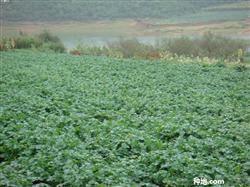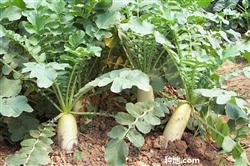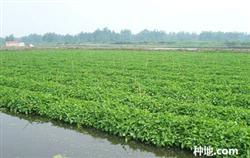How to fertilize cabbage and radish scientifically?

How to fertilize cabbage and radish scientifically? Please introduce Chinese cabbage as an important leafy vegetable. The yield of Chinese cabbage is very high, which can reach more than 5000 kilograms per mu, so there are more requirements for fertilizer. The ratio of them was 1 ∶ 0.4 ∶ 1.1. Therefore, Chinese cabbage, like other leafy vegetables, adequate nitrogen nutrition is of great significance to promote the formation of hypertrophic green leaves and improve photosynthesis during the vegetative growth period. Because the growth amount and growth rate of Chinese cabbage are different in different growth periods, the requirements for nutritional conditions are also different. The general law of fertilizer absorption is as follows: less nutrients are absorbed at the seedling stage, and the absorption of nitrogen, phosphorus and potassium is less than 1% of the total absorption: it increases significantly in the rosette stage, accounting for about 30% of the total absorption; and the absorption is the most in the pericardium stage, accounting for about 70% of the total. Key points of fertilization techniques: (1) the application of sufficient organic fertilizer and sufficient base fertilizer is the basis for a bumper harvest of Chinese cabbage. In general, the soil fertility of the old vegetable field is high, and the application of organic fertilizer should be appropriate, while the soil fertility of the new vegetable field is not high, so it is particularly important to re-apply the mixture of organic fertilizer and phosphate fertilizer as base fertilizer. (2) skillfully apply seedling fertilizer after cotyledons of Chinese cabbage grow, the main root has reached about 10 cm, and the first-order lateral root has the ability to absorb water and fertilizer. When the basal fertilizer is insufficient or no seed fertilizer is applied, a small amount of seedling fertilizer should be applied, 5kg urea per mu to promote its growth. When fertilizing, emphasis should be placed on the application of small and weak seedlings to promote the formation of strong seedlings. (3) reasonable topdressing should grasp the beginning of the seedling cluster to enter the rosette stage and the first two times of topdressing, which is the key to ensure the high yield of Chinese cabbage. At this time, Chinese cabbage is in the period of rapid growth, so the amount of topdressing should be increased, mainly nitrogen fertilizer, combined application of nitrogen fertilizer and phosphorus and potassium fertilizer, or regular application of water manure. During the growth period, foliar spraying of 1000 times diluted Ke Zi 891 plant growth hormone (titanium citrate water agent) or 0.5% of 1% urea and potassium dihydrogen phosphate mixture can increase the net vegetable rate of Chinese cabbage and increase the commodity value. (4) paying attention to the application of potash fertilizer and increasing potash fertilizer can enhance the disease resistance and storage tolerance of Chinese cabbage, but the application of potash fertilizer is often ignored in production. The general amount of potassium application is 20 kg of potassium sulfate or 15 kg of potassium chloride. Some plant ash can be applied when there is a lack of chemical potash fertilizer. It should be pointed out that if the nitrogen supply is insufficient during the growing period, the plant of Chinese cabbage is short, the tissue is rough, and the yield is seriously reduced; if too much nitrogen fertilizer is applied, Chinese cabbage is not tolerant to storage. If the supply of phosphorus and potassium is insufficient in the later stage, the heading type vegetables are often not easy to set balls. Chinese cabbage is a calcium-loving crop. When physiological calcium deficiency occurs in bad environmental conditions, dry burning heart disease often occurs, which seriously affects the product quality. Radish and carrot are root vegetables. They are eaten by people with fat fleshy roots. For every 1000 kg of radish, it is necessary to absorb 2.1 kg of nitrogen (N), 0.8 kg of phosphorus (P2O5) and 3.8 kg of potassium (K2O) 5.6 kg from the soil. The ratio of them is 1 ∶ 0.2 ∶ 0.8, which shows that radish is a potassium-loving crop. The absorption of nitrogen, phosphorus and potassium by radish varies greatly in different growth stages. Generally, the absorption of nitrogen in seedling stage is more than that of phosphorus and potassium. In the early stage of fleshy root expansion, the potassium uptake of plants increased significantly, followed by nitrogen and phosphorus, and the peak of nutrient absorption was in the peak period of fleshy root expansion, which accounted for 77.3% of the total nitrogen uptake in the whole growth period. the amount of phosphorus uptake accounted for 82.9% of the total phosphorus absorption, and potassium absorption accounted for 76.6% of the total potassium absorption. Therefore, ensuring adequate nutrition in this period is the key to the high yield of radish. Key points of fertilization techniques: (1) Base fertilizer is generally more than 2000 kg per mu of rotten fertilizer, combined with phosphorus and potassium fertilizer. (2) topdressing, on the basis of proper topdressing in the early stage, when radish belly was broken, combined with irrigation, urea was applied to 10 kg per mu. The application of nitrogen fertilizer should not be too much or too late, and should be applied before the peak period of radish expansion as far as possible. if applied too much or too late, it will easily break the fleshy root or produce bitterness and affect the quality of radish. In the peak period of radish expansion, more potash fertilizer is needed. In addition, attention should be paid to nutrient balance. It is reported that the application of ternary compound fertilizer can increase the yield and improve the quality of radish compared with urea alone. Click for more radish planting techniques click to get more vegetable planting techniques
- Prev

How to manage planting white radish
How to manage the planting of white radish? Please refer to the following techniques for planting white radish: 1. The seedlings grow rapidly after they are unearthed, and the seedlings should be planted in time, otherwise crowded sunshade will occur and lead to overgrowth. Interseedling should be early, generally interseedling 2 times, the first time in 2 to 3 true leaves, interseedling principle to eliminate the inferior and preserve the good, when the belly is broken.
- Next

How to grow asparagus on the surface of water?
How to grow asparagus on the surface of water? Please guide the techniques of planting asparagus on the surface of the water: 1. Make seedlings: when the branches growing from the nodes are 20 cm long, cut off the seedlings with fibrous roots as seedlings. 2. Cultivation methods: prepare braided grass rope, stake and float.
Related
- Where is it suitable to grow horseradish in China? it is expected to see the middle altitude horseradish in Alishan.
- How to prevent tomato virus disease reasonably? (Control methods included)
- Many people like to plant towel gourd on the balcony. What are the main points of this method and management?
- What crops can chili peppers be mixed with?
- Fertilization techniques and matters needing attention in Tomato
- What are the grafting techniques for peach seedlings in spring?
- Harm and control methods of root swelling disease of Chinese cabbage
- What are the pests of sweet potatoes? How to prevent and cure it?
- Symptoms, causes and Control methods of navel Rot in Tomato
- The cause of "Cucumber rotten bibcock" in Farmers' planting Cucumber and its Control Plan

